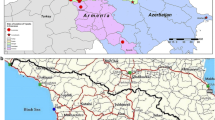Abstract
In order to further figure out the genetic differences between Yersinia pestis and Yersinia pseudotuberculosis, and to provide novel insights into the evolution of Y. pestis, we compared the genomes of Y. pseudotuberculosis serogroup I strain ATCC29833 and Y. pestis Antiqua strain 49006 using a combination of suppression subtractive hybridization (SSH) and comparative genomic hybridization with DNAs from a diverse panel of Y. pestis and Y. pseudotuberculosis strains. SSH followed by BLAST analysis revealed 112 SSH fragments specific to strain ATCC29833, compared to the genomic sequence data of Y. pestis strains CO92, KIM and 91001. We identified 17 SSH fragments that appeared to be newly determined genetic contents of Y. pseudotuberculosis. The combination of SSH and microarray analysis showed that the parallel loss of genes contributed greatly not only to the significant genomic divergence between Y. pestis and Y. pseudotuberculosis but also to the intra-species microevolution of both of species. The results confirmed our earlier hypothesis that Y. pestis Antiqua isolates from the natural plague focus B in China represented the most ancestral strains in China, hence phylogenetically the closest isolates to Y. pseudotuberculosis.



Similar content being viewed by others
References
Achtman M, Zurth K, Morelli G, Torrea G, Guiyoule A, Carniel E (1999) Yersinia pestis, the cause of plague, is a recently emerged clone of Yersinia pseudotuberculosis. Proc Natl Acad Sci USA 96:14043–14048
Bercovier H et al (1980) Intra- and interspecies relatedness of Yersinia pestis by DNA hybridization and its relationship to Yersinia pseudotuberculosis. Curr Microbiol 4:225–229
Boyd EF, Brussow H (2002) Common themes among bacteriophage-encoded virulence factors and diversity among the bacteriophages involved. Trends Microbiol 10:521–529
Bruneteau M, Minka S (2003) Lipopolysaccharides of bacterial pathogens from the genus Yersinia: a mini-review. Biochimie 85:145–152
Brussow H, Canchaya C, Hardt WD (2004) Phages and the evolution of bacterial pathogens: from genomic rearrangements to lysogenic conversion. Microbiol Mol Biol Rev 68:560–602
Canchaya C, Proux C, Fournous G, Bruttin A, Brussow H (2003) Prophage genomics. Microbiol Mol Biol Rev 67:238–276
Chain PS et al (2004) Insights into the evolution of Yersinia pestis through whole-genome comparison with Yersinia pseudotuberculosis. Proc Natl Acad Sci USA 101:13826–13831
Deng W et al (2002) Genome sequence of Yersinia pestis KIM. J Bacteriol 184:4601–4611
Eisen MB, Spellman PT, Brown PO, Botstein D (1998) Cluster analysis and display of genome-wide expression patterns. Proc Natl Acad Sci USA 95:14863–14868
Hai R et al (2004) Molecular biological characteristics and genetic significance of Yersinia pestis in China. Zhonghua Liu Xing Bing Xue Za Zhi 25:509–513
Hinchliffe SJ et al (2003) Application of DNA microarrays to study the evolutionary genomics of Yersinia pestis and Yersinia pseudotuberculosis. Genome Res 13:2018–2029
Ji S et al (1990) The discovery and research of plague natural foci in China (in Chinese). Chin J Epidemiol 11(Suppl):1–41
Mantripragada KK, Buckley PG, de Stahl TD, Dumanski JP (2004) Genomic microarrays in the spotlight. Trends Genet 20:87–94
Parkhill J et al (2001) Genome sequence of Yersinia pestis, the causative agent of plague. Nature 413:523–527
Perry RD, Fetherston JD (1997) Yersinia pestis—etiologic agent of plague. Clin Microbiol Rev 10:35–66
Radnedge L, Agron PG, Worsham PL, Andersen GL (2002) Genome plasticity in Yersinia pestis. Microbiology 148:1687–1698
Skurnik M, Peippo A, Ervela E (2000) Characterization of the O-antigen gene clusters of Yersinia pseudotuberculosis and the cryptic O-antigen gene cluster of Yersinia pestis shows that the plague bacillus is most closely related to and has evolved from Y. pseudotuberculosis serotype O:1b. Mol Microbiol 37:316–330
Song Y et al (2004) Complete genome sequence of Yersinia pestis strain 91001, an isolate avirulent to humans. DNA Res 11:179–197
Tong Z et al (2005) Pseudogene accumulation might promote the adaptive microevolution of Yersinia pestis. J Med Microbiol 54:259–268
Winstanley C (2002) Spot the difference: applications of subtractive hybridisation to the study of bacterial pathogens. J Med Microbiol 51:459–467
Wren BW (2003) The yersiniae—a model genus to study the rapid evolution of bacterial pathogens. Nat Rev Microbiol 1:55–64
Zhou D, Han Y, Song Y, Huang P, Yang R (2004a) Comparative and evolutionary genomics of Yersinia pestis. Microbes Infect 6:1226–1234
Zhou D et al (2004b) DNA microarray analysis of genome dynamics in Yersinia pestis: insights into bacterial genome microevolution and niche adaptation. J Bacteriol 186:5138–5146
Zhou D et al (2004c) Genetics of metabolic variations between Yersinia pestis biovars and the proposal of a new biovar, microtus. J Bacteriol 186:5147–5152
Acknowledgments
We are grateful to Jingxiang Li and Changfeng Li in Beijing Genomics Institute for their assistance in sequencing. Financial support for this work came from the National Natural Science Foundation of China (No. 30471554).
Author information
Authors and Affiliations
Corresponding author
Additional information
Xiaoyi Wang and Dongsheng Zhou contributed equally to this work.
Electronic supplementary material
Rights and permissions
About this article
Cite this article
Wang, X., Zhou, D., Qin, L. et al. Genomic comparison of Yersinia pestis and Yersinia pseudotuberculosis by combination of suppression subtractive hybridization and DNA microarray. Arch Microbiol 186, 151–159 (2006). https://doi.org/10.1007/s00203-006-0129-1
Received:
Revised:
Accepted:
Published:
Issue Date:
DOI: https://doi.org/10.1007/s00203-006-0129-1




